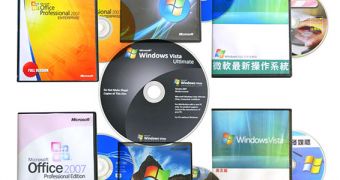Pirated software has grown to become the ugly face of the software industry, hurting not only the vendors and their environment of partners, but also end users. Whether it's made available on the black market via bootlegged media, through peer-to-peer file sharing networks, or sold and installed as genuine solutions, pirated software is not limited to home users but it is also widespread in corporate environments. A new whitepaper on the piracy phenomenon authored by market analysis company IDC and sponsored by Microsoft and the International Association of Microsoft Certified Partners identifies no less than nine reasons which fuel software piracy.
"In interviews with software ecosystem members for this whitepaper we learned that a customer's decision to use pirated or unlicensed software, if, in fact, the customer knew it was doing so could come about for a number of reasons," IDC stated.
The monetary aspect is at the top of the list and for good reason. Pirated software is often cheaper if not even free in comparison to the genuine products. This is why when the decision is made to resort to using counterfeit software, the cost is the main catalyst which points customers in the "right" direction.
But it's not always about the price tag, it's also about complex licensing programs which cause sufficient confusion and end up deterring the customers away from the genuine software. Pirated software can also be deployed as a way to fill in the gaps left in IT infrastructures in order to address immediate needs. In this last scenario, slow moving procurement policies, as well as organizations that grow at fast pace, faster than legitimate licenses can be supplied.
At the same time, permissive master licenses, as well as trial software which is no longer controlled following implementation contribute to the list of reasons why customers run pirated software. Moreover, there are also cases in which customers are tricked into buying counterfeit solutions bundled with hardware or not, by third parties masquerading as legitimate resellers. Attracted mainly by the low cost of such deals, companies often find afterwards that the price of going genuine is too high and unaffordable.
Here are the nine reasons as outlined by IDC for Microsoft:
1. As a deliberate attempt to save money; 2. The pirated software came bundled with the hardware; 3, Cash flow issues... the customer has the money, just not today; 4. Procurement policies that burden IT staff. Who then use demo products to solve immediate IT needs; 5. Company operations that grow faster than procurement increases legitimate licenses; 6. An initial solution that has pirated software bundled into it, and when the company goes to upgrade it can't afford the sudden cost to become legal; 7. A master license agreement that is negotiated elsewhere in the company than where the software is used - confusion between implementers and procurement; 8. Easily available demo or trial software that ends up deployed as production software; the vendor may never follow up; 9. Vendor licensing programs that are too complex; users just give up.

 14 DAY TRIAL //
14 DAY TRIAL //